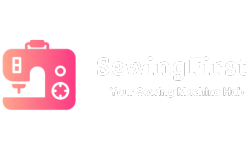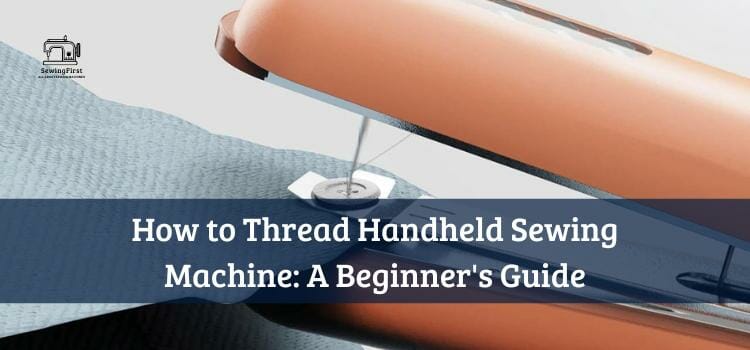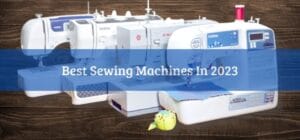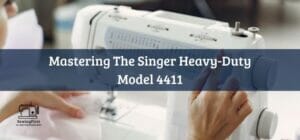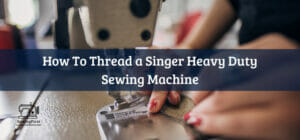Have you ever tried to learn how to use a handheld sewing machine? If so, you know it can be an intimidating task. Trying to thread the needle is one of the most challenging parts of getting started, and often requires lots of trial and error.
But fear not! With this guide on how to thread a handheld sewing machine properly, you’ll soon become confident enough to start your own projects with ease.
The key to success when learning something new is having the right information at your fingertips. That’s why we’ve put together this comprehensive article – full of tips and tricks for successful threading that will help get you up and running in no time.
You’ll find all the essential steps clearly laid out; from preparing the machine correctly before starting, to troubleshooting any problems which may arise along the way.
So if you’re ready to take control and master this tricky yet important skill, then read on as we reveal everything you need to know about how to thread handheld sewing machine like a pro!
Related Topic: How to Thread a Singer 248: Effortless, Step-by-Step Guide
Table of Contents
ToggleWhat is a Handheld Sewing Machine?
A handheld sewing machine is a portable and powerful tool for DIYers. It’s perfect for making quick fixes and alterations, as well as creating homemade projects like clothing or curtains. Unlike traditional machines, the handheld sewing machine doesn’t require an external power source; it’s battery-powered and lightweight so you can take it anywhere!
Plus there are lots of features to help make your stitching easier: tension disks that adjust stitch length and width, an automatic thread cutter, a spool of thread holders, and more.
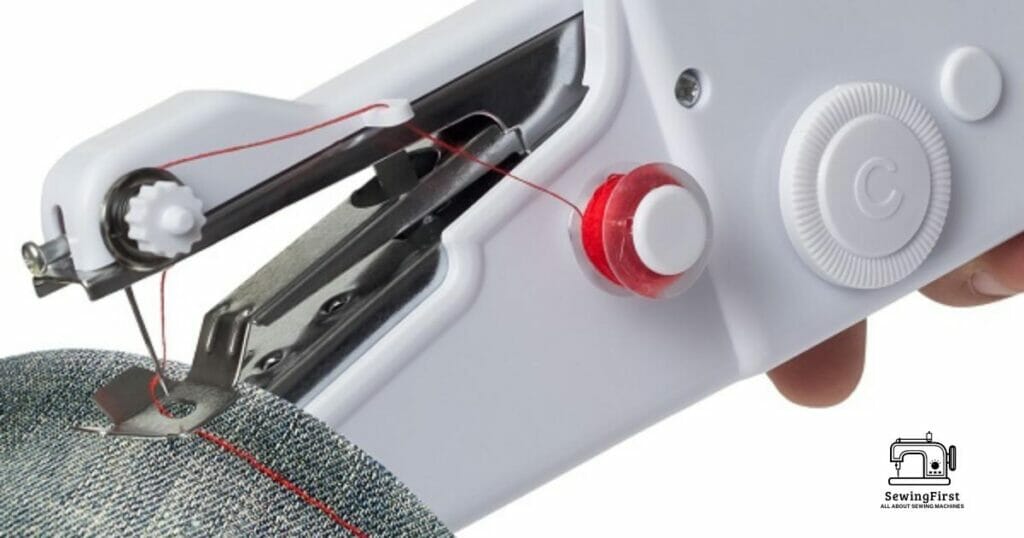
But how does this mini sewing machine work? Portable sewing machines use two basic operations – the needle up/down button which raises or lowers the needle into the fabric, and the reverse/forward switch which controls the direction of the stitches being sewn.
You will also find dials on some models which allow you to control the speed at which you sew. By using these functions together with various accessories such as bobbins, presser feet, zipper foot, etc., you can get creative with many different types of fabrics.
How Does a Handheld Sewing Machine Work?
Using a handheld sewing machine is an easy way to stitch fabric without the bulk of a traditional sewing machine. But how does it work? A handheld sewing machine operates using a chain stitch mechanism, where thread from a portable spool passes through the needle and creates stitches in the material.
It’s similar in concept to hand-sewing, but you don’t need to push the needle manually — instead, this compact device uses mechanical movement to do all the hard work for you!
To use a handheld sewing machine, simply insert your threaded needle into the desired fabric and press down firmly until it reaches the threaded hole. Then move the handle back and forth while pressing lightly with your finger against the fabric.
This will cause the needle to pass through multiple times, creating a neat row of stitching along your project’s edges or seams. The handy size makes it perfect for quick repairs or alterations when you’re away from home — no more waiting until you get back before fixing that ripped seam!
Advantages Of a Handheld Sewing Machine
Handheld sewing machines can be a great boon for those who want to take their hand-sewing projects on the go. These devices offer many advantages that make them worth considering when embarking upon a new project. From convenience to product details, handheld sewing machines bring efficiency and ease of use into every creative endeavor!
The first advantage of these handy tools is portability – they are compact enough to fit in most bags or purses. This makes it easy to work on your project while traveling or at home without needing an entire setup of equipment.
Additionally, the thread spool pin, thread guide, and thread spindle all come already attached so you don’t need any additional accessories. You can just grab your machine and get started immediately!
Furthermore, since these machines have fewer parts than traditional models, there’s no need for extensive product research before purchasing one – simply look up the specifications online and find one that best suits your needs.
Overall, using a handheld sewing machine has its perks – from being more convenient to having less hassle during purchase time. With this device around, projects can become much easier!
Disadvantages Of a Handheld Sewing Machine
A handheld sewing machine is a great tool to have when you don’t want the bulk of a larger model. While they offer plenty of advantages, there are some drawbacks to consider.
For starters, all handheld sewing machines require manual operation and do not feature an automated foot pedal or motorized speed control like traditional models. This means that precision stitching can be more difficult and time-consuming, especially for inexperienced sewers who may find it hard to keep their hands steady while using the device.
Additionally, most handheld devices are only suitable for lightweight fabrics such as silk and cotton; any heavier material will likely cause the machine to jam or break due to strain on its small components. Moreover, many lack an awl for sewing leather which limits their use even further.
Overall, these limitations mean that making complex projects with a handheld sewing machine isn’t always feasible – so if you’re looking into purchasing one, make sure to think through what type of tasks you’ll need it for before selecting the right model for your needs.
Understanding how different features work together is essential in order to choose wisely and ensure successful results with your handmade items!
How To Choose A Handheld Sewing Machine
“Necessity is the mother of invention,” they say, and this has never been more true than when it comes to handheld sewing machines. Making repairs on your own garments or working with heavy fabrics can be a daunting task – but with the right tools and knowledge, you can make magic happen! So how do you choose the best handheld sewing machine for you?
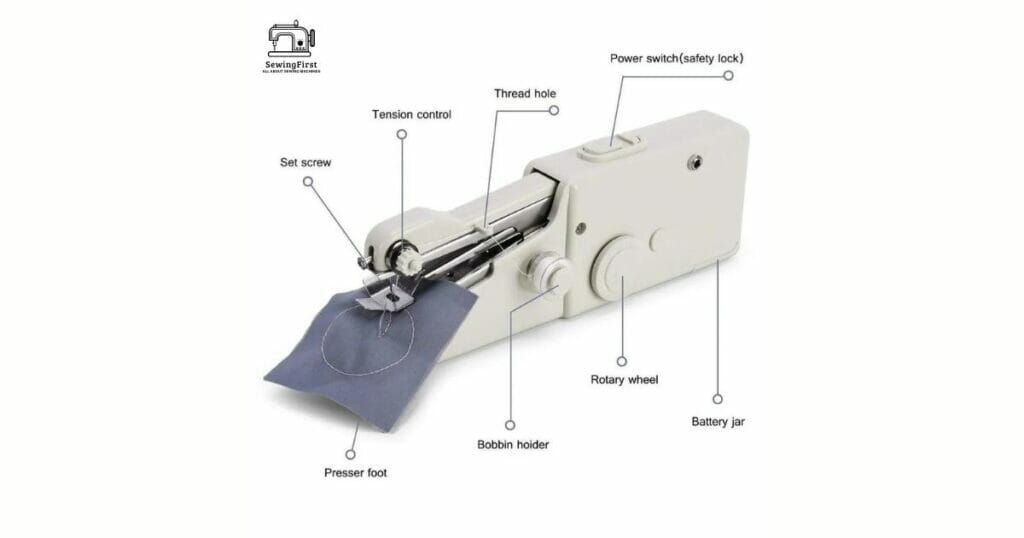
To start off, consider what type of projects you plan on doing most often. Do you need a basic chain stitch sewing machine that produces straight lines? Or would a Smartex USA Handheld Sewing Machine provide all the features you need? Here are three things to look for:
Quality construction
The last thing you want is equipment that’s going to break down during an important project. Choose a durable product made from quality materials.
Versatility
Look for a handheld machine that offers multiple stitching patterns and settings so that no matter what kind of fabric or job comes up, you’ll have options available at your fingertips.
Ease of use
Make sure any instructional manual provided is simple and easy to understand, as well as tips on how to troubleshoot common issues with your new device.
Once you’ve found the perfect fit, get ready to create beautiful fashion pieces in record time! With just one small tool, there are endless possibilities ahead. Now let’s dig into whether these handy little devices really measure up.
Are Handheld Sewing Machines Any Good?
Are handheld sewing machines any good? Absolutely! Despite their smaller size, these powerful little devices offer all of the same features you’d expect to find in a full-size sewing machine.
With an adjustable foot pedal and a range of product descriptions to choose from, it’s easy to find one that fits your needs. Plus, they are incredibly portable so you can take them wherever you go – perfect for busy sewers on the move.
Of course, there is always the risk of having excess thread when using a handheld sewing machine, but with proper maintenance and care this should not be a problem.
Follow the manufacturer’s instructions carefully to ensure your machine runs smoothly and keeps producing quality results every time. With regular cleaning and tune-ups, you’ll have no trouble getting great performance out of your handheld sewing machine for years to come!
Other Handheld Sewing Machines To Consider
Are you ready to take the plunge and purchase a handheld sewing machine? If so, it’s important to know what other options are available before deciding. Let’s dive in! Like a shining beacon of hope for sewers everywhere, the LKJ mini sewing professional cordless stands out from the crowd. It offers portability and convenience with features that rival full-size sewing machines. Here are three reasons why this model is worth your consideration:
- Sturdy construction – This model is made from high-grade materials, offering superior stitching capabilities and durability.
- Lightweight design – Weighing only 4 lbs, this machine is easy to transport and store away when not in use.
- Quality components – A powerful motor ensures smooth operation while noise levels are kept to an absolute minimum.
If you’re looking for a dependable handheld sewing machine review, then this one should be at the top of your list. Not only does it offer exceptional value but its versatility makes it suitable for beginners as well as experienced users alike.
Plus, with recent changes to make usage easier than ever before – such as improved thread tension control – you can be sure that whatever project you have on hand will be completed successfully and quickly!
How To Use A Handheld Sewing Machine
Whether you’re a novice or an experienced sewer, having the right handheld sewing machine can make all the difference. Take for example Anita, who was looking to complete her latest project with a rechargeable battery-powered device so she wouldn’t be tied down to one spot in her house.
After researching many product descriptions and reviews of assorted sewing notions, she decided on a reliable and affordable handheld sewing machine. Now that she had her ideal tool it was time to learn how to use it properly!
With just a few simple steps, Anita quickly learned how to thread her handheld sewing machine without any help. She found that with practice comes mastery – something that every sewer should strive for when working on their projects.
By following the instructions carefully and taking the time to become familiar with each step, Anita was able to start making progress toward completing her first-ever handmade creation. With confidence derived from experience sewing, Anita is now well on her way towards becoming an expert at using her new handy tool.
How To Thread Handheld Sewing Machine: Steps to Follow
Whether you’re a beginner or an expert seamstress, threading a handheld sewing machine can be tricky. After all, these mini-machines are much smaller than their regular and traditional full-size counterparts,
So the steps to follow may differ from those of larger models. But with the right technique and tools, like an AC adapter for your device, you can easily get your miniature stitching buddy up and running in no time!
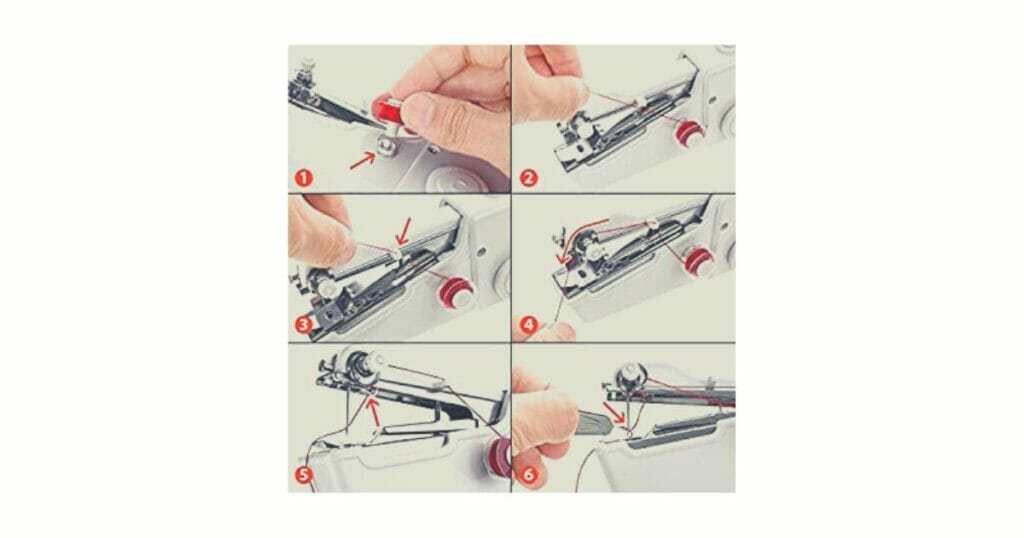
Let’s start by gathering all the materials needed:
- a spool of matching thread (or two if you need contrasting colors),
- scissors,
- a needle threader (if included),
- a piece of scrap fabric
Once everything is within reach, it’s time to begin. Unscrew the bobbin case located on either side of the handheld sewing machine and remove it along with its accompanying tension disc – this will make inserting the new thread easier.
Now pull out some length of your chosen thread – enough that both ends meet at least halfway across your workspace – then tie off one end into several knots until secure.
Next use either your fingers or a pair of tweezers to insert the knotted end through the appropriate slot inside the bobbin case before pulling halfway through and trimming any excess threads off neatly with scissors.
Finally, adjust the tension wheel according to manufacturer guidelines before replacing back into its original position on top of your machine. With that done you should now have successfully threaded your handheld sewing machine!
Essential Supplies and Tools For Handheld Sewing Machines
It’s like stepping back into a time machine; the satisfying sound of needle and thread, gliding through fabric with its gentle hum. It’s essential to have all the right supplies and tools when working with a handheld sewing machine – you don’t want any malfunctions on the way!
From your Sewing Machine to an Accessory Kit, here are the essential supplies for using a Handheld Sewing Machine.
First up is Thread – it comes in handy when stitching together pieces of fabric or mending tears. You’ll need various colors of thread depending on what project you’re working on – from neutral black or white hues to vibrant colors that can add vibrancy to your finished product.
Then there’s the actual Handheld Sewing Machine itself – make sure to select one that has adjustable speeds so you can customize it according to your project needs. There are also extra accessories available such as bobbins, needles, and presser feet which will come in useful at different times too.
Lastly, an accessory kit should include scissors, measuring tape, thimbles, and other items that may be beneficial throughout your project.
With these essentials in hand, you’ll be ready to tackle projects big and small with ease!
Tips for Beginners using a Handheld Sewing Machine
Using a handheld sewing machine is like rowing a boat in the sea of fabrics. With knowledge and practice, you can reach your destination faster while avoiding any unwanted turbulence.
To start off on your journey with this heavy-duty tool, there are some essential items that need to be in tow. You will require an accessory kit, a sized sewing machine, thread, and patience if you are a beginner.
Assembling these components together is not as daunting as it may seem; with attention to detail and guidance from experts or tutorials online, one can quickly become acquainted with their new device.
Taking precautionary measures such as reading through user manuals before use or consulting experienced professionals for advice also helps ensure the safe handling of the equipment. Allowing oneself time to learn and adjust to the different settings of the handheld device is key – don’t rush into it!
Instead, take small steps until you feel confident enough to navigate through more complicated projects. Transitioning into troubleshooting common issues with a handheld sewing machine will help eliminate future problems down the line.
Common Troubleshooting For Handheld Sewing Machines
So, you’ve got your heavy-duty sewing machine with included accessory kit and are ready to use it. But what happens when something goes wrong? Don’t worry – troubleshooting a handheld sewing machine isn’t as difficult as it seems! In this section, we’ll cover the most common issues encountered while using one of these machines.
The first thing that might happen is getting thread jammed in the needle or bobbin area. This can be easily fixed by carefully removing the threads from around the needle and then rethreading both the top and bottom parts of the machine.
If tension appears to be off, just adjust it until you find an even balance between too tight and too loose. Additionally, if there are any skipped stitches happening, check that your presser foot is firmly secured in place. That should take care of any stitching problems you may have experienced so far.
Now that you’ve identified some frequent glitches associated with sewers like yours, let’s move on to another important topic: basic maintenance for a handheld sewing machine.
Basic Maintenance for a Handheld Sewing Machine
Keeping a handheld sewing machine in top condition is just like taking care of a beloved pet: doing regular maintenance will keep it running smoothly. Just like brushing your dog’s fur, you should give the machine a good cleaning every now and then to make sure that no lint or dirt builds up on its surface.
To avoid any costly repairs down the line, take some time to regularly inspect the needles, thread tensioners, spool caps, and other moving parts for wear and tear. If these pieces look worn out, replace them as soon as possible with new ones so that they won’t damage any fabrics when used.
Additionally, be sure to store your machine somewhere dry and not too hot or cold—temperature extremes can cause problems over time if left unchecked! By following these simple steps you can ensure that your trusty companion continues to stitch away happily for many years to come.
Projects That Can Be Done With A Handheld Sewing Machine
Ah, the joys of owning a handheld sewing machine: trying to make it through mending without pricking your finger once! But we all know that’s only part of the story.
With proper maintenance and care for our beloved little machines, there are so many more wonders we can create with them. From masks and aprons to complex quilts and patchwork – let’s explore what these nifty tools can do!
The possibilities are truly endless when you have a handheld sewing machine in hand. For starters, they’re great for making quick fixes on clothing such as patching up holes or reinforcing buttons.
If you’ve got some extra fabric lying around, why not whip up a new skirt or dress? Or if you want something simpler yet still stylish, try out an infinity scarf or headband. And don’t forget about accessories like bags and wallets too. The options are practically limitless here.
These handy devices are also great for crafting projects like scrapbooking and card-making. Get creative by adding fun details such as feathers and sequins onto pages and cards using embroidery stitches; who knows where this could lead you?
Quilting fans will be delighted at how easy it is to work on small blocks with these machines – perfect for customizing bedsheets or creating mini wall hangings! All in all, these tiny dynamos really come alive when used for various DIY projects – just use your imagination and get started!
Conclusion
In conclusion, handheld sewing machines are a great tool for anyone who wants to take up the craft of sewing. They are relatively easy to use and can be used to create a range of projects with minimal fuss. Whether you’re an experienced sewer or just getting started, it’s worth investing in one of these handy machines.
Using a handheld sewing machine is like having your own personal seamstress at your fingertips – you can quickly produce professional-looking results without breaking the bank.
Not only that, but they offer plenty of flexibility when it comes to tackling different materials. With a little practice and know-how, I’m sure you’ll find yourself creating beautiful garments and objects in no time!
FAQs
How do you thread a simple handheld sew?
1. Start by finding the eye of the needle and threading the end of the thread through it.
2. Pull the thread through until you have a loop of thread at the other end.
3. Place the thread loop in between your index finger and thumb.
4. Pull the end of the thread until the loop is tight around your fingers.
5. Hold the needle in one hand, and with your other hand, pull the loop of thread down the length of the needle.
6. Hold onto the loop with one hand, and with the other hand, wind the end of the thread around the needle four or five times.
7. Carefully pull the loop off of your fingers and push the thread tight against the needle.
8. Cut the remaining thread, leaving a short tail.
9. You’re now ready to sew!
How do you thread a mini portable sewing machine?
1. Start by plugging the machine into a power source.
2. Lift the presser foot lever to raise the presser foot.
3. Put the spool of thread onto the spool pin.
4. Pull the thread through the thread guide and the tension disc.
5. Thread the needle by pulling the thread through the needle eye.
6. Make sure the upper thread and bobbin thread are both pulled through the presser foot.
7. Pull the thread around the bobbin case and thread the bobbin.
8. Pull the bobbin thread up through the needle plate and pull both threads to the back of the machine.
9. Put the bobbin case back into the machine and press the foot pedal to test your threading.
How do you thread a handheld needle?
1. Start by cutting a length of thread. Make sure it is double the length of the project you are working on.
2. Tie a knot at one end of the thread.
3. Insert the needle into the eye of the needle, making sure the eye is facing the same direction as the point.
